Epson PowerLite 4100, PowerLite 4200W, PowerLite 4300 User Guide
PowerLite® 4100/4200W/4300
Multimedia Projector
User’s Guide

Important Safety Information
WARNING: Never look into the projector lens when the lamp is turned on; the bright light can damage your eyes. Never let children look into the lens when it is on. Never open any cover on the projector, except the lamp and filter covers. Dangerous electrical voltages inside the projector can severely injure you. Except as specifically explained in this User’s Guide, do not attempt to service this product yourself. Refer all servicing to qualified service personnel.
WARNING: The projector and its accessories come packaged in plastic bags. Keep plastic bags away from small children to avoid any risk of suffocation.
Caution: When you replace the lamp, never touch the new lamp with your bare hands; the invisible residue left by the oil on your hands may shorten the lamp life. Use a cloth or glove to handle the new lamp.
Copyright Notice
All rights reserved. No part of this publication may be reproduced, stored in a retrieval system, or transmitted in any form or by any means, electronic, mechanical, photocopying, recording, or otherwise, without the prior written permission of Seiko Epson Corporation. The information contained herein is designed only for use with this Epson product. Epson is not responsible for any use of this information as applied to other products.
Neither Seiko Epson Corporation nor its affiliates shall be liable to the purchaser of this product or third parties for damages, losses, costs, or expenses incurred by purchaser or third parties as a result of: accident, misuse, or abuse of this product or unauthorized modifications, repairs, or alterations to this product, or (excluding the U.S.) failure to strictly comply with Seiko Epson Corporation’s operating and maintenance instructions.
Seiko Epson Corporation shall not be liable for any damages or problems arising from the use of any options or any consumable products other than those designated as Original Epson Products or Epson Approved Products by Seiko Epson Corporation.
Trademarks
Epson, Quick Corner, EasyMP, and Instant Off are registered trademarks, and Epson Exceed Your Vision is a registered logomark of Seiko Epson Corporation.
PowerLite and PrivateLine are registered trademarks; SizeWise is a trademark; and Extra Care is a service mark of Epson America, Inc.
Pixelworks, DNX, and the DNX logo are trademarks of Pixelworks, Inc.
General Notice: Other product names used herein are for identification purposes only and may be trademarks of their respective owners. Epson disclaims any and all rights in those marks.
This information is subject to change without notice.
© 2010 Epson America, Inc. |
7/10 |
CPD-28140
2

|
Contents |
|
|
Welcome . . . . . . . . . . . . . . . . . . . . . . . . . . . . . . . . . . . . . |
. 7 |
|
Using Your Documentation . . . . . . . . . . . . . . . . . . . . . . . . . |
. 8 |
|
Getting More Information . . . . . . . . . . . . . . . . . . . . . . . |
. 8 |
|
Registration and Warranty . . . . . . . . . . . . . . . . . . . . . . . . . . |
. 9 |
|
Optional Accessories. . . . . . . . . . . . . . . . . . . . . . . . . . . . . . . |
. 9 |
|
Setting Up the Projector . . . . . . . . . . . . . . . . . . . . . |
11 |
1 |
Unpacking the Projector. . . . . . . . . . . . . . . . . . . . . . . . . . . . |
12 |
|
Additional Components. . . . . . . . . . . . . . . . . . . . . . . . . |
12 |
|
Positioning the Projector . . . . . . . . . . . . . . . . . . . . . . . . . . . |
13 |
|
Connecting to a Computer. . . . . . . . . . . . . . . . . . . . . . . . . . |
16 |
|
Connecting to the Computer Port . . . . . . . . . . . . . . . . . |
17 |
|
Connecting to the BNC Connectors . . . . . . . . . . . . . . . |
18 |
|
Connecting to Video Equipment . . . . . . . . . . . . . . . . . . . . . |
19 |
|
Connecting a Composite Video Source . . . . . . . . . . . . . |
20 |
|
Connecting a Component Video Source . . . . . . . . . . . . |
21 |
|
Connecting an RGB Video Source. . . . . . . . . . . . . . . . . |
22 |
|
Turning the Projector On and Off . . . . . . . . . . . . . . . . . . . . |
23 |
|
Using the Direct Power On Function . . . . . . . . . . . . . . |
25 |
|
Shutting Down the Projector . . . . . . . . . . . . . . . . . . . . . |
26 |
3

|
Displaying and Adjusting the Image . . . . . . . . |
27 |
2 |
Displaying an Image. . . . . . . . . . . . . . . . . . . . . . . . . . . . . . . |
28 |
|
Adjusting the Image . . . . . . . . . . . . . . . . . . . . . . . . . . . . . . . |
28 |
|
Adjusting the Position of the Image . . . . . . . . . . . . . . . . |
29 |
|
Focusing and Zooming the Image . . . . . . . . . . . . . . . . . |
30 |
|
Adjusting the Image Shape. . . . . . . . . . . . . . . . . . . . . . . |
30 |
|
Selecting the Color Mode . . . . . . . . . . . . . . . . . . . . . . . |
32 |
|
Resizing Video Images . . . . . . . . . . . . . . . . . . . . . . . . . . |
33 |
|
Presenting With the Remote Control . . . . . . . . |
35 |
3 |
Using the Remote Control . . . . . . . . . . . . . . . . . . . . . . . . . . |
36 |
|
Controlling the Picture. . . . . . . . . . . . . . . . . . . . . . . . . . . . . |
36 |
|
Switching Between Picture Sources . . . . . . . . . . . . . . . . |
36 |
|
Turning Off the Picture. . . . . . . . . . . . . . . . . . . . . . . . . |
37 |
|
Stopping Action. . . . . . . . . . . . . . . . . . . . . . . . . . . . . . . |
37 |
|
Zooming Part of Your Image . . . . . . . . . . . . . . . . . . . . . |
37 |
|
Highlighting Your Presentation . . . . . . . . . . . . . . . . . . . . . . |
38 |
|
Using the Pointer Tool . . . . . . . . . . . . . . . . . . . . . . . . . |
38 |
|
Choosing a Different Pointer Shape. . . . . . . . . . . . . . . . |
39 |
|
Operating Your Computer With the Remote Control . . . . . |
39 |
|
Operating Two or More Projectors With the Remote Control40 |
|
|
Setting the Projector ID. . . . . . . . . . . . . . . . . . . . . . . . . |
40 |
|
Checking the Projector ID. . . . . . . . . . . . . . . . . . . . . . . |
41 |
|
Setting the Remote Control ID . . . . . . . . . . . . . . . . . . . |
42 |
|
Using the Projector on a Network. . . . . . . . . . . |
43 |
4 |
Connecting to a Wired Network . . . . . . . . . . . . . . . . . . . . . |
44 |
|
Configuring Basic Settings . . . . . . . . . . . . . . . . . . . . . . . . . . |
46 |
|
Using Projector E-mail Alerts . . . . . . . . . . . . . . . . . . . . . . . . |
47 |
|
Using SNMP to Monitor the Projector . . . . . . . . . . . . . . . . |
48 |
|
Using a Browser to Control the Projector. . . . . . . . . . . . . . . |
49 |
|
Using Web Remote Control . . . . . . . . . . . . . . . . . . . . . |
50 |
4

|
Fine-Tuning the Projector. . . . . . . . . . . . . . . . . . . |
53 |
5 |
Using the Menu System . . . . . . . . . . . . . . . . . . . . . . . . . . . . |
54 |
|
Restoring the Default Settings . . . . . . . . . . . . . . . . . . . . |
55 |
|
Adjusting the Image . . . . . . . . . . . . . . . . . . . . . . . . . . . . . . . |
56 |
|
Six-Axis Color Adjustment. . . . . . . . . . . . . . . . . . . . . . . |
57 |
|
Adjusting Signal Settings . . . . . . . . . . . . . . . . . . . . . . . . . . . |
58 |
|
Customizing Projector Features . . . . . . . . . . . . . . . . . . . . . . |
60 |
|
Using the Projector Security Features . . . . . . . . . . . . . . . . . . |
62 |
|
Enabling Password Protection . . . . . . . . . . . . . . . . . . . . |
62 |
|
Creating Your Own Startup Screen . . . . . . . . . . . . . . . . |
64 |
|
Disabling the Projector’s Buttons . . . . . . . . . . . . . . . . . . |
66 |
|
Customizing Power and Operation. . . . . . . . . . . . . . . . . . . . |
67 |
|
Multi-screen Color Adjustment . . . . . . . . . . . . . . . . . . . . . . |
69 |
|
Projector Menu and Options List . . . . . . . . . . . . . . . . . . . . . |
70 |
|
Maintaining the Projector. . . . . . . . . . . . . . . . . . . |
73 |
6 |
Cleaning the Lens . . . . . . . . . . . . . . . . . . . . . . . . . . . . . . . . . |
74 |
|
Cleaning the Projector Case . . . . . . . . . . . . . . . . . . . . . . . . . |
74 |
|
Cleaning the Air Filter . . . . . . . . . . . . . . . . . . . . . . . . . . . . . |
74 |
|
Replacing the Air Filter. . . . . . . . . . . . . . . . . . . . . . . . . . . . . |
77 |
|
Replacing the Lamp . . . . . . . . . . . . . . . . . . . . . . . . . . . . . . . |
78 |
|
Resetting the Lamp Timer . . . . . . . . . . . . . . . . . . . . . . . |
81 |
|
Checking Lamp Usage . . . . . . . . . . . . . . . . . . . . . . . . . . |
82 |
|
Replacing the Batteries . . . . . . . . . . . . . . . . . . . . . . . . . . . . . |
82 |
|
Transporting the Projector . . . . . . . . . . . . . . . . . . . . . . . . . . |
83 |
|
Solving Problems . . . . . . . . . . . . . . . . . . . . . . . . . . . . |
85 |
7 |
Using On-Screen Help . . . . . . . . . . . . . . . . . . . . . . . . . . . . . |
86 |
|
Checking Projector Status. . . . . . . . . . . . . . . . . . . . . . . . . . . |
87 |
|
What To Do When the Lights Flash . . . . . . . . . . . . . . . |
87 |
|
Solving Projector Operation Problems . . . . . . . . . . . . . . . . . |
89 |
|
Solving Problems With the Image. . . . . . . . . . . . . . . . . . . . . |
90 |
|
Solving Network Problems . . . . . . . . . . . . . . . . . . . . . . . . . . |
96 |
5

|
Solving Problems With the Remote Control . . . . . . . . . . . |
. 97 |
|
Where To Get Help . . . . . . . . . . . . . . . . . . . . . . . . . . . . . . |
. 97 |
|
Internet Support . . . . . . . . . . . . . . . . . . . . . . . . . . . . . |
. 98 |
|
Speak to a Support Representative . . . . . . . . . . . . . . . . |
. 98 |
|
Purchase Supplies and Accessories . . . . . . . . . . . . . . . . |
. 99 |
|
Projector Installation . . . . . . . . . . . . . . . . . . . . . . . |
101 |
A |
Installation Guidelines . . . . . . . . . . . . . . . . . . . . . . . . . . . . |
101 |
|
Security Features . . . . . . . . . . . . . . . . . . . . . . . . . . . . . . . . |
102 |
B Technical Specifications . . . . . . . . . . . . . . . . . . . . |
105 |
|
C Notices . . . . . . . . . . . . . . . . . . . . . . . . . . . . . . . . . . . . . . 113
Important Safety Instructions . . . . . . . . . . . . . . . . . . . . . . . 113
FCC Compliance Statement. . . . . . . . . . . . . . . . . . . . . . . . 116
Index. . . . . . . . . . . . . . . . . . . . . . . . . . . . . . . . . . . . . . . . 119
6

-
Welcome
The PowerLite® 4100/4200W/4300 is an easy-to-use, lightweight projector. It offers up to 4500 lumens (PowerLite 4100/4200W) or 5200 lumens (PowerLite 4300) of brightness, and provides a native XGA (PowerLite 4100 and 4300) or WXGA (PowerLite 4200W) resolution. You can connect it to a wide range of computers and video sources.
Your projector offers these easy setup, control, and security features:
■Manual horizontal and vertical lens shift
■Centered lens design
■Instant Off ® feature for fast setup and shut down
■Quick Corner® for easy image shape/size adjustment
■1.8x optical zoom lens for flexible placement and positioning
■One-touch filter replacement
■Side-loading easy lamp access
■Security features include password, user’s logo, the ability to lock the projector buttons, a security cable attachment (cable not included), a slot for an optional Kensington® security lock, and a lens theft deterrent screw
Additional enhancements:
■Closed captioning for the hearing impaired
■1000:1 contrast ratio
■Color match images from two or more projectors for a uniform, wide-screen view
7

■When you present with PowerPoint®, project only the slide images while viewing handout notes and controls on the computer screen
■Perform six-axis color adjustment for fine art and photography
Using Your Documentation
This electronic User’s Guide contains all the information you need to set up and use your projector.
Please follow these guidelines as you read through this manual:
■Warnings must be followed carefully to avoid bodily injury.
■Cautions must be observed to avoid damage to your equipment.
■Notes contain important information about your projector.
■Tips contain additional projection hints.
Getting More Information
Need tips on giving presentations? Quick steps for setting up your projector? Here’s where you can look for help:
■Quick Reference card
Provides information for connecting the projector to your equipment, displaying and adjusting the image, using the remote control, and solving display problems.
■EasyMP Monitor Operation Guide
Provides instructions on using the EasyMP Monitor software (available for Windows only) to manage projectors on a network (to download both the software and the guide, visit Epson’s support website at www.epson.com/support (U.S.) or www.epson.ca/support (Canada) and select your product).
■Built-in help system
Provides assistance for common problems. Available from the Help button on the projector or the remote control. See page 86 for details.
8 Welcome

■epson.com/support (U.S.) or epson.ca/support (Canada)
Download FAQs and e-mail your questions to Epson support.
■PrivateLine® support
If you still need help after checking this User’s Guide and the sources listed in this section, you can use the Epson PrivateLine Support service to get help fast. Call (800) 637-7661 and enter the PIN on the PrivateLine card. See page 97 for more information.
Registration and Warranty
Your projector comes with a basic warranty that lets you project with confidence. For details, see the warranty brochure included with your projector.
In addition, Epson offers free Extra CareSM Road Service. In the unlikely event of an equipment failure, you won’t have to wait for your unit to be repaired. Instead, Epson will ship you a replacement unit anywhere in the United States or Canada. See the brochure included with your projector for details.
Register online using your projector CD or at epson.com/webreg. Registering also lets you receive special updates on new accessories, products, and services.
Optional Accessories
To enhance your use of the projector, Epson offers the following optional accessories:
Product |
Part number |
|
|
Replacement lamp for PowerLite 4100 |
V13H010L62 |
|
|
Replacement lamp for PowerLite 4200W and 4300 |
V13H010L63 |
|
|
Replacement air filter |
V13H134A17 |
|
|
Wireless IR Mouse Receiver for Remote Control |
V12H007T16 |
|
|
Replacement remote control |
1531179 |
|
|
Welcome 9

Product |
Part number |
|
|
Advanced projector ceiling mount with precision gear |
ELPMBPRG |
Adjustable suspended ceiling channel kit |
ELPMBP01 |
False ceiling plate kit |
ELPMBP02 |
Structural round ceiling plate |
ELPMBP03 |
Adjustable extension column (pipe) 8”–11” |
ELPMBC01 |
|
|
Kensington® MicroSaver®security lock |
ELPSL01 |
|
|
ES3000 Ultra Portable Projector Screen |
V12H002S3Y |
50-inch portable screen (4:3 aspect ratio) |
ELPSC06 |
60-inch portable pop-up screen (4:3 aspect ratio) |
ELPSC07 |
80-inch portable pop-up screen (4:3 aspect ratio) |
ELPSC08 |
DUET™ portable projector screen |
ELPSC80 |
|
|
Component-to-VGA video cable |
ELPKC19 |
|
|
Distribution amplifier |
ELPDA01 |
|
|
DC-10s document camera |
ELPDC10S |
|
|
1-Year Extended Depot Repair Service Plan |
EPPFTPB1 |
|
|
1-Year Extended Exchange Warranty |
EPPEXPB1 |
|
|
2-Year Extended Depot Repair Service Plan |
EPPFTPB2 |
|
|
You can purchase screens or other accessories from an Epson authorized reseller. To find the nearest reseller, call 800-GO-EPSON (800-463-7766). Or you can purchase online at www.epsonstore.com (U.S. sales) or www.epson.ca (Canadian sales).
10 Welcome

Setting Up the Projector
This chapter tells you how to unpack the projector and connect it to a notebook or desktop computer, to video equipment, and/or to your local area network.
Follow the instructions in this chapter on:
■Unpacking the projector
■Positioning the projector
■Connecting to a computer
■Connecting to video equipment
■Turning the Projector On and Off
11

note
If you mount the projector on the ceiling, the interface and button names on the projector will appear upside down. Attach the interface label stickers so that you can more easily read the names.
Unpacking the Projector
After unpacking the projector, make sure you have all these parts:
PDF manuals and registration CD-ROM
Projector and lens cap
Lens theft |
Remote control and |
Password Protected |
deterrent screw |
2 AA batteries |
sticker |
Power cord |
VGA computer cable |
Interface label stickers |
|
Save all packaging in case you need to ship the projector. Always use the original packaging (or the equivalent) when you need to send the projector to another location. If you are moving the projector by hand, use the projector handle. See page 83 for transportation instructions.
Additional Components
Depending on how you plan to use the projector, you may need additional components:
■To receive a component video signal from your video device, you’ll need a component video cable. One may be provided with your video equipment.
12 Setting Up the Projector

■To receive an RGB or component video signal from a video device that has RGB or component (PrPbY or CrCbY) connectors, you’ll need a BNC-type video cable. One may be provided with your video equipment.
Positioning the Projector
If the projector isn’t already installed in the room you’re using, you’ll probably want to place it on a table in front of the screen. This lets you stand in the front of the room, face the audience, and remain close enough to the equipment to be able to control it. Try to leave as much space as possible between the projector and the screen to get a good-size image.
Use the illustrations and tables below to help you determine placement. Image size increases with distance, but can vary depending on whether you’ve adjusted the image with vertical lens shift, zoom, or any other settings.
You can also use the Image Size Calculator on the Epson website.
note
You can mount the projector on the ceiling, or place it behind a translucent screen for rear projection. See page 101 for details.
Center of |
lens |
Center of lens
Setting Up the Projector 13

PowerLite 4100/4300, 4:3 image
|
Projection distance (A) |
|
Screen size |
Wide to Tele |
Offset (B) |
|
|
|
30 inches |
30 to 56 inches |
0 to 18 inches |
|
(77 to 142 cm) |
(0 to 46 cm) |
|
|
|
40 inches |
41 to 75 inches |
0 to 24 inches |
|
(104 to 190 cm) |
(0 to 61 cm) |
|
|
|
50 inches |
52 to 94 inches |
0 to 30 inches |
|
(131 to 239 cm) |
(0 to 76 cm) |
|
|
|
60 inches |
62 to 113 inches |
0 to 36 inches |
|
(158 to 287 cm) |
(0 to 91 cm) |
|
|
|
80 inches |
84 to 151 inches |
0 to 48 inches |
|
(213 to 385 cm) |
(0 to 122 cm) |
|
|
|
100 inches |
105 to 190 inches |
0 to 60 inches |
|
(267 to 482 cm) |
(0 to 152 cm) |
|
|
|
150 inches |
159 to 285 inches |
0 to 90 inches |
|
(403 to 725 cm) |
(0 to 229 cm) |
|
|
|
200 inches |
212 to 381 inches |
0 to 120 inches |
|
(539 to 968 cm) |
(0 to 305 cm) |
|
|
|
250 inches |
266 to 477 inches |
0 to 150 inches |
|
(675 to 1211 cm) |
(0 to 381 cm) |
|
|
|
300 inches |
319 to 572 inches |
0 to 180 inches |
|
(811 to 1454 cm) |
(0 to 457 cm) |
|
|
|
14 Setting Up the Projector

PowerLite 4200W, 16:10 image
|
Projection distance (A) |
|
Screen size |
Wide to Tele |
Offset (B) |
|
|
|
30 inches |
32 to 59 inches |
-1.5 to 17.4 inches |
|
(81 to 149 cm) |
(-4 to 44 cm) |
|
|
|
40 inches |
43 to 79 inches |
-2 to 23.2 inches |
|
(109 to 200 cm) |
(-5 to 59 cm) |
|
|
|
50 inches |
54 to 99 inches |
-2.5 to 29 inches |
|
(138 to 251 cm) |
(-6 to 74 cm) |
|
|
|
60 inches |
66 to 119 inches |
-3 to 34.8 inches |
|
(167 to 302 cm) |
(-8 to 88 cm) |
|
|
|
80 inches |
88 to 159 inches |
-4 to 46.4 inches |
|
(224 to 405 cm) |
(-10 to 118 cm) |
|
|
|
100 inches |
111 to 200 inches |
-5 to 58 inches |
|
(281 to 507 cm) |
(-13 to 147 cm) |
|
|
|
150 inches |
167 to 300 inches |
-7.6 to 87.1 inches |
|
(424 to 762 cm) |
(-19 to 221 cm) |
|
|
|
200 inches |
223 to 401 inches |
-10.1 to 116.1 inches |
|
(567 to 1018 cm) |
(-26 to 295 cm) |
|
|
|
250 inches |
280 to 501 inches |
-12.6 to 145.1 inches |
|
(710 to 1273 cm) |
(-32 to 369 cm) |
|
|
|
300 inches |
336 to 602 inches |
-15.1 to 174.1 inches |
|
(853 to 1529 cm) |
(-38 to 442 cm) |
|
|
|
Also keep these considerations in mind:
■Place the projector on a sturdy, level surface.
■Make sure there is plenty of space for ventilation around and under the projector.
■Make sure the projector is within 10 feet (3 meters) of a grounded electrical outlet or extension cord.
Setting Up the Projector 15

note
After positioning the projector, you may want to connect a Kensington MicroSaver® anti-theft device to the lock port on the projector. You can purchase this from Epson; see page 9.
Ideally, you should place the projector directly in front of the center of the screen, facing it toward the screen squarely. The base of the lens should be about level with the bottom of the screen.
Projector
Screen
note
To connect a Macintosh that includes only a Mini DisplayPort or Mini-DVI port for video output, you need to obtain an adapter that allows you to connect to the projector's VGA video port. Contact Apple for compatible adapter options.
If you place the projector below screen level, you can use the vertical lens shift dial to raise the lens (see page 29). You can also tilt the projector up by extending the front adjustable foot. Tilting the projector causes the image to become “keystone” shaped, but you can correct the distortion (see page 30).
For instructions on installing the projector in a permanent location, such as a theater or conference room, see page 101.
Connecting to a Computer
You can connect the projector to any computer that has a standard video output (monitor) port, including desktop models, PC and Macintosh computers, and hand-held devices.
If you have the optional wireless mouse receiver, you can use your remote control as a wireless mouse when projecting from a computer (page 39).
16 Setting Up the Projector
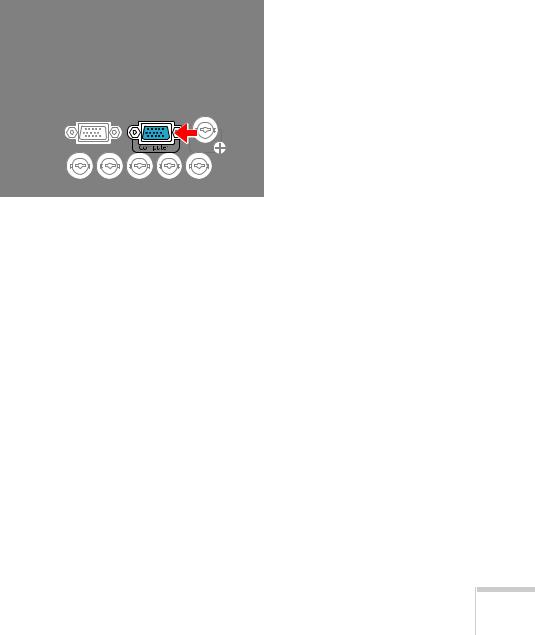
Connecting to the Computer Port
You can connect to the projector using the VGA computer cable that came with it (the monitor port on your computer must be a mini D-sub 15-pin port).
1.If you’re using the VGA computer cable, connect one end to the projector’s Computer1 port, and the other end to your computer’s monitor port.
caution
Don’t try to force a connector to fit a port with a different shape or number of pins. You may damage the port or connector.
2.You may need to change the Input Signal setting in the projector’s Signal menu to RGB (see page 59).
3.With the optional wireless mouse receiver (see page 39), you can use the remote control as a mouse.
4.When you’ve finished making any connections, see page 23 for instructions on turning on the projector and Chapter 2 for instructions on displaying and adjusting the image.
Setting Up the Projector 17
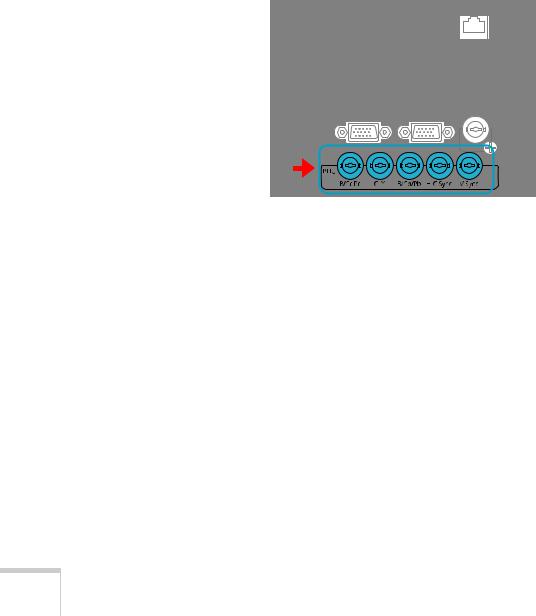
Connecting to the BNC Connectors
1.Obtain a commercially available standard BNC to VGA video cable.
2.Plug the BNC connectors into the projector’s B/Cb/Pb, G/Y, and R/Cr/Pr connectors as shown below. Depending on your computer’s video card, you may have to connect to the projector’s V Sync and H/C Sync connectors too. (See your computer documentation for more information.)
3.Plug the VGA connector on the other end of the cable into your computer’s monitor port.
4.You may need to change the Input Signal setting in the projector’s Signal menu to RGB (see page 59).
5.With the optional wireless mouse receiver (see page 39), you can use the remote control as a mouse.
6.When you’ve finished making any connections, see page 23 for instructions on turning on the projector and Chapter 2 for instructions on displaying and adjusting the image.
18 Setting Up the Projector

Connecting to Video Equipment
You can connect several video sources to the projector at the same time. Before starting, look at your video equipment to determine its available video output connections:
■If your video player has a component video port (three connectors labeled either Y/Cb/Cr or Y/Pb/Pr), see “Connecting a Component Video Source” on page 21.
■If you’re using a coax video cable, see “Connecting a Composite Video Source” on page 20.
BNC connector (component or composite video)
■If your video player has an RGB video port (either a single connector for a VGA monitor cable or three connectors labeled R/G/B), see “Connecting an RGB Video Source” on page 22.
VGA connector (RGB video)
Setting Up the Projector 19

note
If the video cable was not provided with your video device, you can purchase one from an electronics dealer.
Connecting a Composite Video Source
1.If your cable has a bayonet connector (BNC), connect it to the Video1 connector on the projector.
2.When you’ve finished making any connections, see page 23 for instructions on turning on the projector and Chapter 2 for instructions on displaying and adjusting the image.
20 Setting Up the Projector

Connecting a Component Video Source
1.Look at the connectors at one end of your component video cable. If they are bayonet (BNC) connectors, go on to step 2. If they are RCA connectors, you’ll need to attach commercially available BNC adapters to plug the cable into your projector, then continue with step 2.
2.Connect the cable to your player and the BNC connectors on the projector. Match the Y/Cb/Cr (or Y/Pb/Pr) connectors on your player to the corresponding connectors on the projector.
note
If the component video cable was not provided with your video device, you can purchase one from an electronics dealer.
note
Be sure your video player is not an RGB video source. If you select the wrong source, image quality may suffer. Check your video player’s documentation.
Also, make sure the Input Signal setting in the Signal menu is set to Auto or Component (see page 59).
3.You may need to change the Input Signal setting in the projector’s Signal menu to Component (see page 59).
4.When you’ve finished making any connections, see page 23 for instructions on turning on the projector and Chapter 2 for instructions on displaying and adjusting the image.
note
If you have a component-to-VGA video cable, you can use it to connect a component video source. Connect the VGA connector to the projector’s
Computer1 port, then connect the other end of the cable to your player.
Setting Up the Projector 21
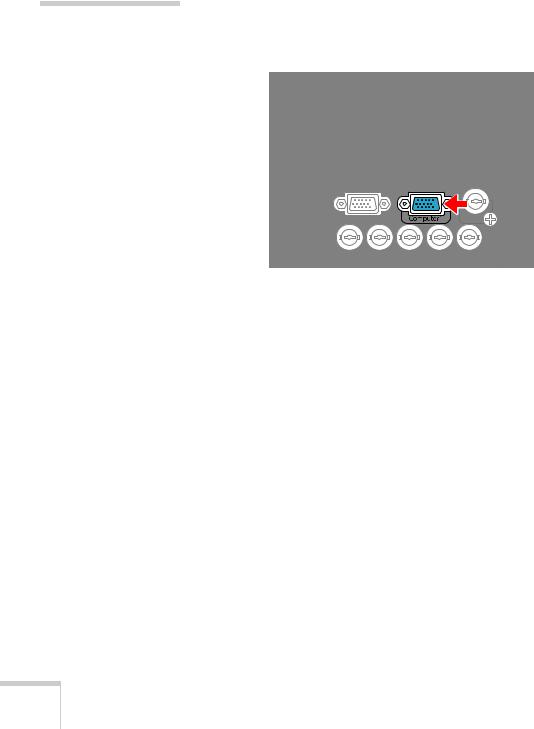
note
Be sure your video player is
not a component video source. If you select the wrong source, image quality may suffer. Check your video player’s documentation.
Connecting an RGB Video Source
Connecting Using a VGA Computer Cable
1.Locate the VGA computer cable provided with the projector.
2.Connect the cable to the video port on your player and the Computer1 port on the projector.
3.You may need to change the Input Signal setting in the projector’s Signal menu to RGB (see page 59).
4.When you’ve finished making any connections, see page 23 for instructions on turning on the projector and Chapter 2 for instructions on displaying and adjusting the image.
22 Setting Up the Projector

Connecting Using a BNC Cable
1.Locate a BNC video cable (one may be included with your video equipment).
2.Connect the cable between your player and the corresponding R/G/B connectors on the projector.
3.You may need to change the Input Signal setting in the projector’s Signal menu to RGB (see page 59).
4.When you’ve finished making any connections, see page 23 for instructions on turning on the projector and Chapter 2 for instructions on displaying and adjusting the image.
Turning the Projector On and Off
Turn on any connected computer or video equipment before starting the projector so it can automatically detect and display the image source. If you turn on the projector first, or have multiple pieces of connected equipment, you may have to select the image source manually (see page 28).
Setting Up the Projector 23

Follow these steps to turn on the projector:
1. Remove the lens cover.
note
You can set the projector to automatically turn off the lamp and enter “sleep mode” when it has not received any signals for 1 to 30 minutes (see page 67 to enable, disable, or adjust this setting). This conserves electricity, cools the projector, and extends the life of the lamp. If you want to start projecting again, press the P power button. If you are done using the projector, unplug the power cord.
2.Plug one end of the power cord into the projector, and the other end into an electrical outlet.
The P power light turns orange.
Power light
24 Setting Up the Projector

3.Press the P power button on the remote control or on the back of the projector.
The projector beeps once and the P power light flashes green as the projector warms up, then an image begins to appear. When the P power light stops flashing and remains green, the projector is ready for use.
4. If you are prompted to enter a password, see page 63.
Using the Direct Power On Function
The Direct Power On function enables faster setup. The projector starts up automatically when you plug it in or turn it on with a wall switch. You don’t have to press the P power button.
Follow these steps to enable Direct Power On:
1.Press the Menu button on the remote control or projector, then select the Extended menu and press Enter.
2.Choose Operation and press Enter.
3.Choose Direct Power On and press Enter.
warning
Never look into the lens when the lamp is on. This can damage your eyes, and is especially dangerous for children and pets.
4.Highlight On and press Enter.
5.Press Menu to exit. The setting will take effect the next time you plug in the projector.
note
If a power outage occurs when Direct Power On is enabled and the projector is plugged in, the projector will restart when the power is restored.
Setting Up the Projector 25

note
Turn off this product when not in use to prolong the life of the projector.
Shutting Down the Projector
This projector incorporates Instant Off technology. To turn it off, you can press its P power button as described below, unplug it, or turn off a power switch that supplies power to the projector. You don’t have to wait for the projector to cool down first.
1.To turn off the projector, press the P power button on the remote control or projector.
You see a confirmation message. (If you don’t want to turn it off, press any other button.)
2.Press the P power button again. The projection lamp turns off and the projector beeps twice, and you can unplug the power cord.
If you want to turn the projector on again, make sure the orange P power light is not flashing, then press the P power button.
26 Setting Up the Projector

Displaying and Adjusting
the Image
Follow the guidelines in this chapter for:
■Displaying an image
■Adjusting the image
27

note
The projector can display a test pattern to help you adjust some image settings. See page 60.
Displaying an Image
You may need to select the image source if you have multiple video sources connected to the projector (such as a computer or DVD player). Selecting the image source lets you switch between images input from different pieces of connected equipment.
If you don’t see the image you want, press the Search button or one of the Source buttons on the remote control, or the Source Search button on the projector until you see the image you want to project.
You can also use the Source buttons on the remote control to switch between devices connected to the ports identified on each button.
Adjusting the Image
Once you see your image, you need to make certain adjustments:
■If the image is too high or too low, reposition it as described on page 29.
■To focus or zoom your image, see page 30.
■If the image isn’t square, see page 30.
■To quickly adjust the color, brightness, or contrast, see page 32.
■To change the image aspect ratio, see page 33.
■If you need to fine-tune the image, see Chapter 5.
28 Displaying and Adjusting the Image
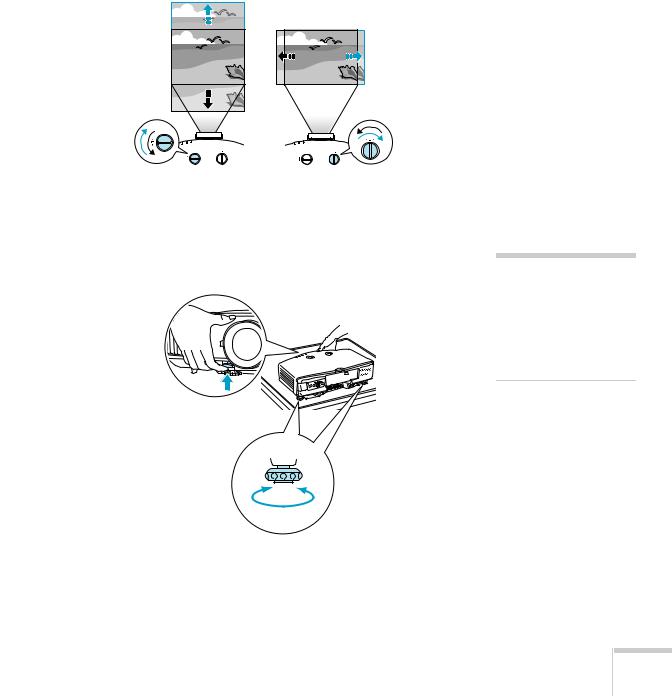
Adjusting the Position of the Image
You can use the vertical lens shift dial on the top of the projector to move your image up or down, or you can use the horizontal lens shift dial to move your image left or right.
Vertical |
Horizontal |
Additionally, if the projector is on a table, you can use the projector’s adjustable feet to adjust the image:
1.Stand behind the projector. Press the foot release lever up and lift the front of the projector.
2.Once the image is positioned where you want it, release the lever to lock the foot in position.
note
Raising the projector with the front adjustable foot causes the image shape to distort or “keystone,” but you can correct the shape as described on page 30.
Displaying and Adjusting the Image 29
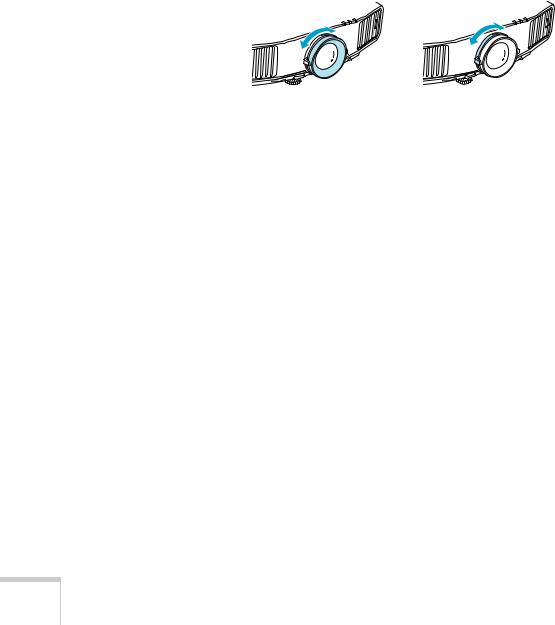
3.If necessary, you can fine-tune the height or level the image by turning any of the projector’s adjustable feet.
Focusing and Zooming the Image
Turn the focus ring on the projector to sharpen the image.
Turn the zoom ring (using the knobs on the ring) to reduce or enlarge the image.
Focus |
Zoom |
If the image still isn’t large enough, you may need to move the projector farther away from the screen. You can also use the buttons on the remote control to zoom in on a portion of the image. See page 37 for instructions.
Adjusting the Image Shape
You can maintain a square or rectangular image by placing the projector directly in front of the screen and keeping it level. This also produces the best picture quality. If the projector is tilted up or placed at an angle, you’ll need to correct the image shape by using one of the functions described below.
Using Quick Corner
Use Quick Corner to adjust the shape and size of the image when it’s uneven on all sides. Follow these steps to select Quick Corner:
1.Press the Menu button on the remote control or the projector.
2.Select the Settings menu and press Enter.
3.From the Settings menu, select Keystone and press Enter.
4.Select Quick Corner and press Enter twice.
30 Displaying and Adjusting the Image
